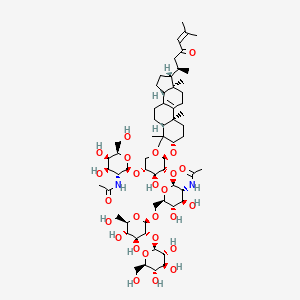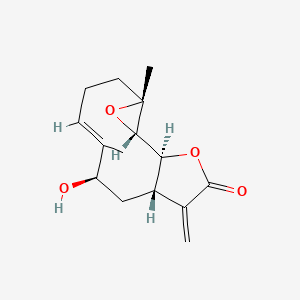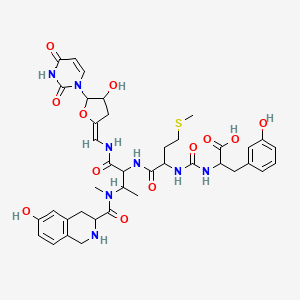
ニロチニブ塩酸塩
概要
説明
ニロチニブ塩酸塩は、フィラデルフィア染色体陽性の慢性骨髄性白血病(CML)の治療に主に用いられる医薬品である。これは、もう1つのチロシンキナーゼ阻害剤であるイマチニブへの耐性を克服するために開発された第2世代チロシンキナーゼ阻害剤である。 ニロチニブ塩酸塩は、タシグナという商品名で販売されており、新規診断されたCMLとイマチニブ耐性CMLの両方の治療における有効性で知られている .
2. 製法
合成ルートと反応条件: ニロチニブ塩酸塩の合成は、ベンザミド誘導体を含むコア構造の調製から始まる複数ステップを伴う。このプロセスは通常、以下のステップを含む。
コア構造の形成: コア構造は、カップリング剤の存在下で4-メチル-3-ニトロ安息香酸と4-メチル-1H-イミダゾールを反応させることによって合成される。
還元: ニトロ基は、典型的にはメタノール媒体中でラネーニッケルを使用して、触媒的ハイドロジェネーションによってアミンに還元される.
工業的製造方法: ニロチニブ塩酸塩の工業的製造は、同様の合成ルートに従うが、大規模製造に最適化されている。 このプロセスは、製薬製剤に不可欠なニロチニブ塩酸塩の安定な結晶形を形成することを保証する .
科学的研究の応用
Nilotinib hydrochloride has several scientific research applications:
作用機序
ニロチニブ塩酸塩は、フィラデルフィア染色体によって生成されるBCR-ABLタンパク質のチロシンキナーゼ活性を阻害することでその効果を発揮する。それはBCR-ABLタンパク質のATP結合部位に結合し、そのリン酸化活性を阻害する。 この阻害は、白血病細胞の生存と増殖に不可欠な下流のシグナル伝達経路をブロックする .
類似化合物:
イマチニブ: CMLの治療に使用される第1世代チロシンキナーゼ阻害剤。ニロチニブ塩酸塩は、イマチニブへの耐性を克服するために開発された。
ダサチニブ: CMLの治療に使用されるもう1つの第2世代チロシンキナーゼ阻害剤。
ボスチニブ: CML治療に使用される第3世代チロシンキナーゼ阻害剤。
ニロチニブ塩酸塩の独自性: ニロチニブ塩酸塩は、イマチニブと比較して、BCR-ABLタンパク質に対するより高い効力と特異性があるため、ユニークである。 また、いくつかのイマチニブ耐性BCR-ABL変異に対しても効果的であるため、イマチニブに反応しない患者にとって貴重な選択肢となっている .
生化学分析
Biochemical Properties
Nilotinib hydrochloride plays a crucial role in biochemical reactions by inhibiting the activity of several tyrosine kinases, including BCR-ABL, c-KIT, and platelet-derived growth factor receptor (PDGFR). It binds to the ATP-binding site of these kinases, preventing their phosphorylation and subsequent activation. This inhibition disrupts the signaling pathways that promote cell proliferation and survival . Nilotinib hydrochloride also interacts with other biomolecules such as EPHA3, EPHA8, DDR1, DDR2, MAPK11, and ZAK, further contributing to its anti-leukemic effects .
Cellular Effects
Nilotinib hydrochloride exerts significant effects on various cell types and cellular processes. In leukemic cells, it inhibits the BCR-ABL kinase, leading to reduced cell proliferation and increased apoptosis. This compound also affects cell signaling pathways, including those mediated by c-KIT and PDGFR, which are involved in cell growth and differentiation . Additionally, nilotinib hydrochloride influences gene expression and cellular metabolism, contributing to its therapeutic efficacy in CML .
Molecular Mechanism
The molecular mechanism of action of nilotinib hydrochloride involves its binding to the ATP-binding site of the BCR-ABL kinase, stabilizing its inactive conformation. This binding prevents the phosphorylation of downstream signaling proteins, thereby inhibiting the proliferation of leukemic cells . Nilotinib hydrochloride also inhibits other tyrosine kinases, such as c-KIT and PDGFR, by a similar mechanism, further contributing to its anti-cancer effects .
Temporal Effects in Laboratory Settings
In laboratory settings, the effects of nilotinib hydrochloride have been observed to change over time. The compound is relatively stable, but its efficacy can decrease due to degradation and the development of resistance in leukemic cells . Long-term studies have shown that continuous exposure to nilotinib hydrochloride can lead to sustained inhibition of BCR-ABL kinase activity and prolonged survival of treated cells . Resistance mechanisms, such as mutations in the BCR-ABL gene, can reduce its effectiveness over time .
Dosage Effects in Animal Models
In animal models, the effects of nilotinib hydrochloride vary with different dosages. At therapeutic doses, it effectively inhibits the proliferation of leukemic cells and reduces tumor burden . At higher doses, nilotinib hydrochloride can cause toxic effects, including hepatotoxicity and cardiotoxicity . Studies have shown that there is a threshold dose above which the adverse effects outweigh the therapeutic benefits .
Metabolic Pathways
Nilotinib hydrochloride is primarily metabolized in the liver through oxidation and hydroxylation, mainly by the enzyme CYP3A4 . The main circulating component in the serum is the parent drug, with its metabolites contributing minimally to its pharmacological activity . The metabolic pathways of nilotinib hydrochloride involve interactions with various enzymes and cofactors, affecting metabolic flux and metabolite levels .
Transport and Distribution
Within cells and tissues, nilotinib hydrochloride is transported and distributed through various mechanisms. It is highly protein-bound in the plasma, with a protein binding rate of approximately 98% . The compound is also an inhibitor of the OATP-1B1 transporter, which affects its distribution and accumulation in specific tissues . The distribution coefficient (D) for nilotinib hydrochloride in n-octanol/0.1 N HCl buffer at 37°C is 0.08, indicating its hydrophilic nature .
Subcellular Localization
Nilotinib hydrochloride is localized within specific subcellular compartments, influencing its activity and function. Studies have shown that it can be internalized by cells and distributed within the cytoplasm and nucleus . The subcellular localization of nilotinib hydrochloride is crucial for its therapeutic effects, as it needs to reach its target kinases to exert its inhibitory action .
準備方法
Synthetic Routes and Reaction Conditions: The synthesis of nilotinib hydrochloride involves multiple steps, starting from the preparation of the core structure, which includes a benzamide derivative. The process typically involves the following steps:
Formation of the Core Structure: The core structure is synthesized by reacting 4-methyl-3-nitrobenzoic acid with 4-methyl-1H-imidazole in the presence of a coupling agent.
Formation of the Hydrochloride Salt: The final step involves converting the intermediate compound into nilotinib hydrochloride by reacting it with hydrochloric acid.
Industrial Production Methods: Industrial production of nilotinib hydrochloride follows a similar synthetic route but is optimized for large-scale production. The process ensures the formation of a stable crystalline form of nilotinib hydrochloride, which is essential for its pharmaceutical formulation .
化学反応の分析
反応の種類: ニロチニブ塩酸塩は、以下を含むさまざまな化学反応を受ける。
酸化: ニロチニブ塩酸塩は、特定の条件下で酸化され、分解生成物を生成する可能性がある。
還元: 合成中に、中間体化合物のニトロ基はアミンに還元される。
置換: 合成には、コア構造に官能基を導入するための置換反応が含まれる。
一般的な試薬と条件:
触媒的ハイドロジェネーション: 還元ステップには、メタノール中のラネーニッケルが使用される。
塩酸: 塩酸塩を形成するために使用される。
主要な生成物:
ニロチニブ塩酸塩: 合成から生成される主な生成物。
分解生成物: 酸化およびその他のストレス条件下で生成される
4. 科学研究への応用
ニロチニブ塩酸塩には、いくつかの科学研究への応用がある。
化学: チロシンキナーゼ阻害剤の合成と安定性を研究するためのモデル化合物として使用される。
生物学: 細胞シグナル伝達経路に対するその影響と、他のキナーゼを阻害する可能性について調査されている。
類似化合物との比較
Imatinib: The first-generation tyrosine kinase inhibitor used to treat CML. Nilotinib hydrochloride was developed to overcome resistance to imatinib.
Dasatinib: Another second-generation tyrosine kinase inhibitor used to treat CML.
Bosutinib: A third-generation tyrosine kinase inhibitor used for CML treatment.
Uniqueness of Nilotinib Hydrochloride: Nilotinib hydrochloride is unique due to its higher potency and specificity for the BCR-ABL protein compared to imatinib. It is also effective against several imatinib-resistant BCR-ABL mutations, making it a valuable option for patients who do not respond to imatinib .
特性
IUPAC Name |
4-methyl-N-[3-(4-methylimidazol-1-yl)-5-(trifluoromethyl)phenyl]-3-[(4-pyridin-3-ylpyrimidin-2-yl)amino]benzamide;hydrochloride | |
|---|---|---|
| Source | PubChem | |
| URL | https://pubchem.ncbi.nlm.nih.gov | |
| Description | Data deposited in or computed by PubChem | |
InChI |
InChI=1S/C28H22F3N7O.ClH/c1-17-5-6-19(10-25(17)37-27-33-9-7-24(36-27)20-4-3-8-32-14-20)26(39)35-22-11-21(28(29,30)31)12-23(13-22)38-15-18(2)34-16-38;/h3-16H,1-2H3,(H,35,39)(H,33,36,37);1H | |
| Source | PubChem | |
| URL | https://pubchem.ncbi.nlm.nih.gov | |
| Description | Data deposited in or computed by PubChem | |
InChI Key |
VTGGYCCJUPYZSX-UHFFFAOYSA-N | |
| Source | PubChem | |
| URL | https://pubchem.ncbi.nlm.nih.gov | |
| Description | Data deposited in or computed by PubChem | |
Canonical SMILES |
CC1=C(C=C(C=C1)C(=O)NC2=CC(=CC(=C2)C(F)(F)F)N3C=C(N=C3)C)NC4=NC=CC(=N4)C5=CN=CC=C5.Cl | |
| Source | PubChem | |
| URL | https://pubchem.ncbi.nlm.nih.gov | |
| Description | Data deposited in or computed by PubChem | |
Molecular Formula |
C28H23ClF3N7O | |
| Source | PubChem | |
| URL | https://pubchem.ncbi.nlm.nih.gov | |
| Description | Data deposited in or computed by PubChem | |
DSSTOX Substance ID |
DTXSID60238968 | |
| Record name | Nilotinib hydrochloride anhydrous | |
| Source | EPA DSSTox | |
| URL | https://comptox.epa.gov/dashboard/DTXSID60238968 | |
| Description | DSSTox provides a high quality public chemistry resource for supporting improved predictive toxicology. | |
Molecular Weight |
566.0 g/mol | |
| Source | PubChem | |
| URL | https://pubchem.ncbi.nlm.nih.gov | |
| Description | Data deposited in or computed by PubChem | |
CAS No. |
923288-95-3 | |
| Record name | Nilotinib hydrochloride anhydrous | |
| Source | ChemIDplus | |
| URL | https://pubchem.ncbi.nlm.nih.gov/substance/?source=chemidplus&sourceid=0923288953 | |
| Description | ChemIDplus is a free, web search system that provides access to the structure and nomenclature authority files used for the identification of chemical substances cited in National Library of Medicine (NLM) databases, including the TOXNET system. | |
| Record name | Nilotinib hydrochloride anhydrous | |
| Source | EPA DSSTox | |
| URL | https://comptox.epa.gov/dashboard/DTXSID60238968 | |
| Description | DSSTox provides a high quality public chemistry resource for supporting improved predictive toxicology. | |
| Record name | 4-Methyl-N-[3-(4-methylimidazol-1-yl)-5-(trifluoromethyl)phenyl]-3-[(4-pyridin-3-ylpyrimidin-2-yl)amino]benzamide hydrochloride | |
| Source | European Chemicals Agency (ECHA) | |
| URL | https://echa.europa.eu/information-on-chemicals | |
| Description | The European Chemicals Agency (ECHA) is an agency of the European Union which is the driving force among regulatory authorities in implementing the EU's groundbreaking chemicals legislation for the benefit of human health and the environment as well as for innovation and competitiveness. | |
| Explanation | Use of the information, documents and data from the ECHA website is subject to the terms and conditions of this Legal Notice, and subject to other binding limitations provided for under applicable law, the information, documents and data made available on the ECHA website may be reproduced, distributed and/or used, totally or in part, for non-commercial purposes provided that ECHA is acknowledged as the source: "Source: European Chemicals Agency, http://echa.europa.eu/". Such acknowledgement must be included in each copy of the material. ECHA permits and encourages organisations and individuals to create links to the ECHA website under the following cumulative conditions: Links can only be made to webpages that provide a link to the Legal Notice page. | |
| Record name | NILOTINIB HYDROCHLORIDE ANHYDROUS | |
| Source | FDA Global Substance Registration System (GSRS) | |
| URL | https://gsrs.ncats.nih.gov/ginas/app/beta/substances/K37N7BYX3X | |
| Description | The FDA Global Substance Registration System (GSRS) enables the efficient and accurate exchange of information on what substances are in regulated products. Instead of relying on names, which vary across regulatory domains, countries, and regions, the GSRS knowledge base makes it possible for substances to be defined by standardized, scientific descriptions. | |
| Explanation | Unless otherwise noted, the contents of the FDA website (www.fda.gov), both text and graphics, are not copyrighted. They are in the public domain and may be republished, reprinted and otherwise used freely by anyone without the need to obtain permission from FDA. Credit to the U.S. Food and Drug Administration as the source is appreciated but not required. | |
Synthesis routes and methods I
Procedure details





Synthesis routes and methods II
Procedure details





Synthesis routes and methods III
Procedure details




Retrosynthesis Analysis
AI-Powered Synthesis Planning: Our tool employs the Template_relevance Pistachio, Template_relevance Bkms_metabolic, Template_relevance Pistachio_ringbreaker, Template_relevance Reaxys, Template_relevance Reaxys_biocatalysis model, leveraging a vast database of chemical reactions to predict feasible synthetic routes.
One-Step Synthesis Focus: Specifically designed for one-step synthesis, it provides concise and direct routes for your target compounds, streamlining the synthesis process.
Accurate Predictions: Utilizing the extensive PISTACHIO, BKMS_METABOLIC, PISTACHIO_RINGBREAKER, REAXYS, REAXYS_BIOCATALYSIS database, our tool offers high-accuracy predictions, reflecting the latest in chemical research and data.
Strategy Settings
| Precursor scoring | Relevance Heuristic |
|---|---|
| Min. plausibility | 0.01 |
| Model | Template_relevance |
| Template Set | Pistachio/Bkms_metabolic/Pistachio_ringbreaker/Reaxys/Reaxys_biocatalysis |
| Top-N result to add to graph | 6 |
Feasible Synthetic Routes
試験管内研究製品の免責事項と情報
BenchChemで提示されるすべての記事および製品情報は、情報提供を目的としています。BenchChemで購入可能な製品は、生体外研究のために特別に設計されています。生体外研究は、ラテン語の "in glass" に由来し、生物体の外で行われる実験を指します。これらの製品は医薬品または薬として分類されておらず、FDAから任何の医療状態、病気、または疾患の予防、治療、または治癒のために承認されていません。これらの製品を人間または動物に体内に導入する形態は、法律により厳格に禁止されています。これらのガイドラインに従うことは、研究と実験において法的および倫理的な基準の遵守を確実にするために重要です。

![[2-[4-Hydroxy-3-[(E)-octadec-9-enoyl]oxyoxolan-2-yl]-2-[(E)-octadec-9-enoyl]oxyethyl] (E)-octadec-9-enoate](/img/structure/B1258716.png)

![methyl (2R,3R)-8-methyl-3-(4-methylphenyl)-8-azabicyclo[3.2.1]octane-2-carboxylate](/img/structure/B1258718.png)
![(4R)-4-[(1E,5E,7E,11R)-11-methoxy-8-methyltetradeca-1,5,7,13-tetraenyl]-2-[(1R,2S)-2-methylcyclopropyl]-4,5-dihydro-1,3-thiazole](/img/structure/B1258721.png)
![methyl (4R)-4-[(10S,13R,14R,17R)-4,4,10,13,14-pentamethyl-3,7,11,15-tetraoxo-2,5,6,12,16,17-hexahydro-1H-cyclopenta[a]phenanthren-17-yl]pentanoate](/img/structure/B1258723.png)
![(1aR,7R,7aR,7bS)-1,1,7,7a-tetramethyl-2,3,5,6,7,7b-hexahydro-1aH-cyclopropa[a]naphthalene](/img/structure/B1258724.png)





![6-(4-methoxyphenyl)-6,7-dihydropyrrolo[2,1-d][1,5]benzothiazepin-7-ol](/img/structure/B1258735.png)

![5-[(2,4,5-Trihydroxyphenyl)methyl]imidazolidine-2,4-dione](/img/structure/B1258737.png)
